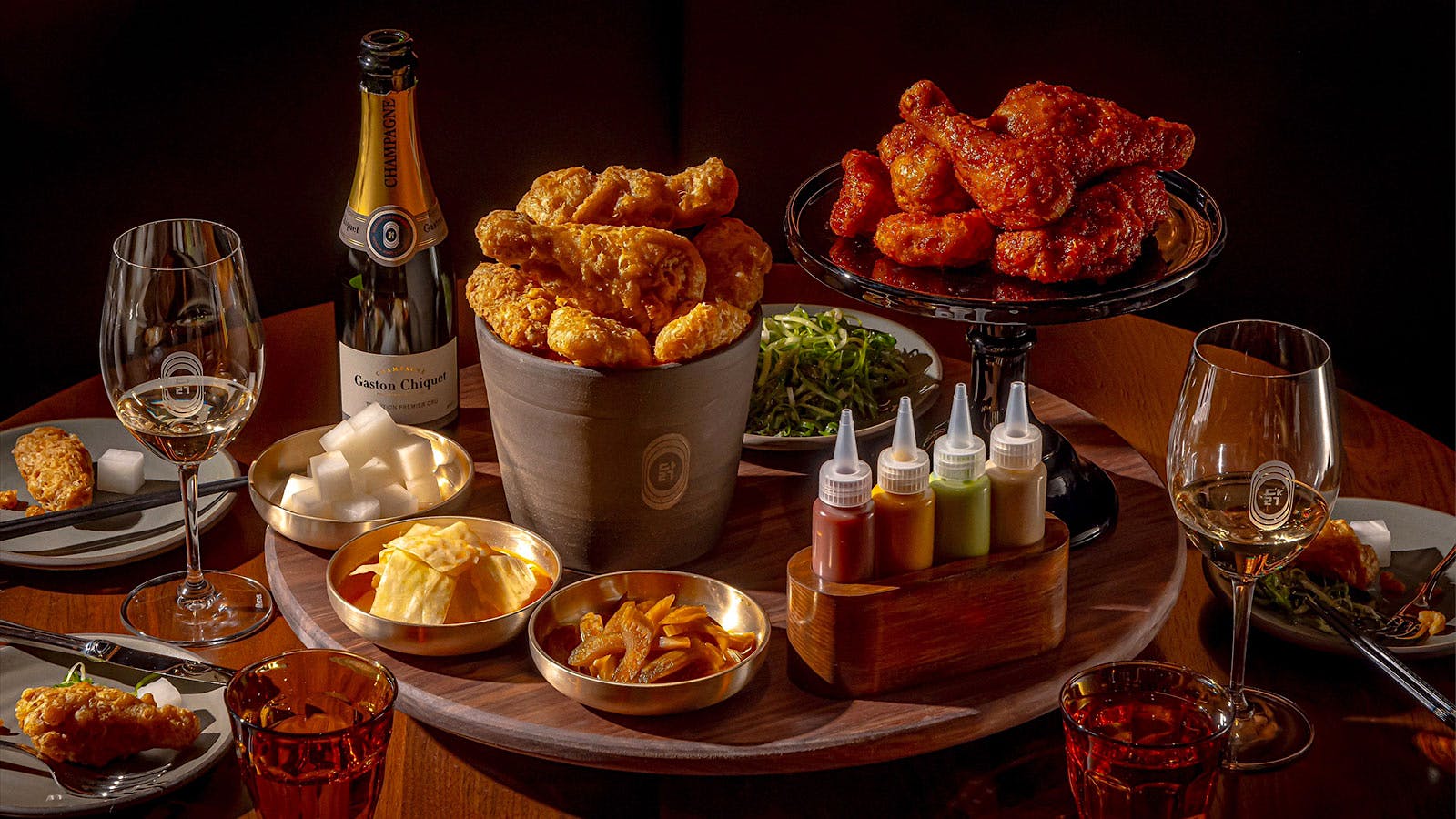Products You May Like
On Jan. 12, Gracious Hospitality Management (GHM), the group behind Cote Korean Steakhouse, is opening its latest restaurant, Coqodaq, which will offer a fine-dining take on wildly popular Korean fried chicken. Ambitiously, the restaurant’s team also plans to build the largest Champagne program in the United States. A project four years in the making, Coqodaq is located on East 22nd Street in Manhattan’s Flatiron District, just down the street from Cote.
Cote has been a fixture among the city’s luxe dining destinations since opening in 2017. While envisioning the restaurant, owner Simon Kim looked to combine the tactile barbecue tradition of Korea with the glitz of New York’s famous steak houses: Using the grill at the center of each table, restaurant staff sear choice cuts of meat for guests, who also enjoy Korean banchan (side dishes) and other small plates. The Wine Spectator Best of Award of Excellence–winning wine program was built for larger groups and parties; there is a stacked list of magnums, and by-the-glass selections are poured exclusively from large-format bottles. In 2021, GHM expanded with the opening of Cote Miami, which offers a similarly impressive wine program.
Coqodaq is the group’s first concept beyond its beef powerhouse. “Simon and our chef SK [Seung Kyu Kim] came up with this concept—he wanted to do what he did for Korean barbeque [for] fried chicken,” Victoria James, GHM’s director of beverage and the author of the memoir Wine Girl, told Wine Spectator. “Fried chicken is this global, universal thing that everyone loves. But right now there isn’t that fried chicken champion in New York. We wanted to put it in the spotlight and also pay homage to Simon and SK’s roots.”

Centered around eum-yang—a philosophical concept that outlines contrasting yet complementary forces in the universe—the menu is based on the balance of fried and hot chicken with palate-cleansing dishes like tangy pickles and chilled perilla seed noodles. (Over the decades, fried chicken has become ubiquitous and incredibly popular in Korea and among Korean communities in other countries; some theorize this began with American soldiers during the Korean War.) At Coqodaq, restaurant staff fill à la carte ceramic buckets with crackling, juicy pieces of Amish chicken served either plain or coated in one of two glazes: savory garlic and soy sauce or fiery-sweet gochujang. Or guests can indulge in a three-course Bucket List prix-fixe feast ($38), which includes roast chicken consommé with red ginseng, a small bucket of chicken with seasonal banchan and perilla seed noodles and, for dessert, frozen yogurt with seasonal fruit.
“People sometimes people think Korean food is so hard to pair with wine because of all the banchan and kimchi elements, which is a fair point. But historically, looking at Europe and classic wine regions, you have this contrast: In Germany you have sauerkraut and sausages. In Lyon, you have pickles and headcheese,” James explained. “You have to look for freshness in the wines, things with a lot of acidity and fruit to contrast those sour and umami notes.”
There was one clear answer for James: Champagne. To her, bubbles are great for fried food, and Champagne’s “high and soaring” acidity cuts through that richness. “It also has so many layers of complexity, so when you are making the best fried chicken, you really need a beverage that can stand up to that,” said James. “It’s also just really, really delicious.”
The focus on Champagne practically calls for a raw bar option as well, and Coqodaq delivers with a trio of tartares, East and West Coast oysters and caviar service.
Championing Champagne
On opening day, there will be 400 Champagnes among the 600 labels on the wine list, with plans to grow even more. James explained that audacity is a huge tenet of the wine programming at GHM, so not only did she want to give Champagne the stage it deserves, she looked to create a wine library with vertical depth and horizontal breadth through which guests can explore larger Champagne houses and grower producers. “You can become this student of Champagne while still having the best time,” James joked. “The more I studied different Champagne programs across the country, I thought that no one was really giving it the spotlight.”
To James, this means reflecting on what Champagne means today. Traveling to Champagne many times in recent years, she spoke with winemakers about what is exciting them in the region and what they think the future looks like. This has a direct result on the Coqodaq wine list; for instance, James dedicates a page to all of Champagne’s Spécial Club bottlings and also highlights the next generation of winemakers, including Mathilde Margaine of A. Margaine and Angéline Templier of J. Lassalle. James is particularly excited for a selection of Leclerc-Briant bottles aged underwater: “They were in the ocean, so they are covered in barnacles. It’s like Titanic shipwreck wine.”
To create an accessible experience, the list opens with a selection of 100 sparkling wines priced less than $100, and at least a third of those bottles are from Champagne. “The one thing that people will say about Champagne is that it’s so unapproachable—especially in price point,” said James. “We have options for everybody.”
On the by-the-glass list, expect well-known bottlings like Billecart Salmon Brut Rosé NV and Veuve Cliquot Brut La Grande Dame 2008. James is also offering a small selection of half-bottles, including Krug’s Brut Grande Cuvée, A. Margaine’s Le Demi-Sec and a Coqodaq-exclusive bottling of Gaston Chiquet’s brut. If guests prefer their wine without bubbles, the still wines primarily come from France, with a slight emphasis on Burgundy.
Coqodaq isn’t the only new GHM endeavor for 2024. Later this month, the group is expected to open its first international restaurant, Cote Singapore, at the Como Metropolitan Singapore hotel. Kim is also headlining a project for the landmarked, Philip Johnson building at 550 Madison Avenue in New York, renovating over three stories atop an iconic piece of Manhattan real estate.
